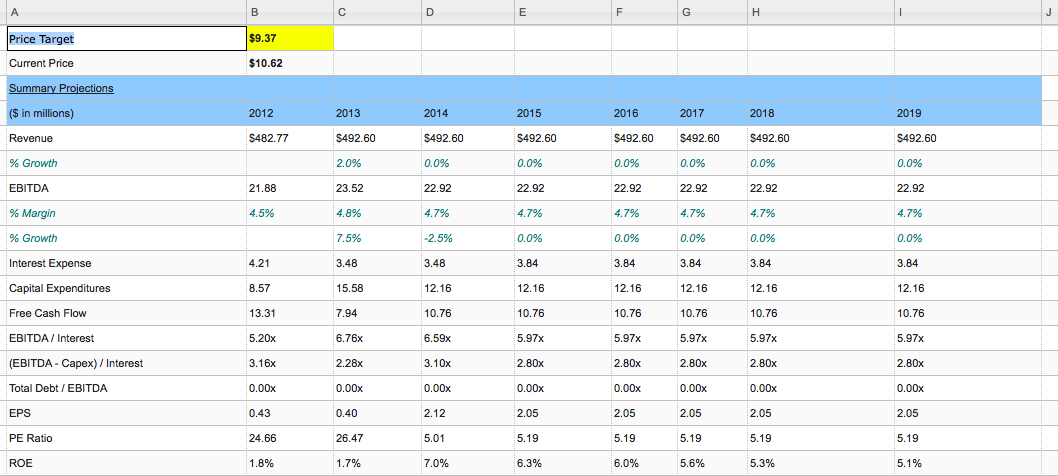Oddball Stocks Why small caps
Post on: 23 Сентябрь, 2015 No Comment

Why small caps?
I have a confession to make, I’m a lousy analyst. I can’t project earnings, or figure out why earnings will shrink because the cost of some obscure thing is going up. I’m not good at discount cash flow analysis, and most sell-side research I’ve read seems heavy on facts but short on anything else. The good news for my portfolio is I’ve adopted an investment methodology that doesn’t rely on any of my weaknesses, and it exploits my strengths.
I’ve had people ask me if I invest in large caps but just don’t discuss them on the blog. I own one, Mastercard, they have a tried and true moat (I can spot an oligopoly..), and they’re growing nicely. I purchased years ago and continue to hold them, if I have a chance to buy other monopolies cheap I would. Otherwise my portfolio is a motley crew of tiny stocks that are unloved and under appreciated. I have invested in large caps in the past, but as I’ve grown as an investor, and seen the opportunities presented in the small cap space compared to the large cap space, I’ve drifted to a smaller and smaller capitalization portfolio. This doesn’t mean I avoid large caps, but the deal needs to be considerably more enticing before I’d be interested.
It’s a heresy to talk about efficient markets with value investors, but I’m going to break the rules. My feeling is that with larger stocks the market generally gets things right. It doesn’t always get it right, but it generally does. To outwit the market in larger stocks one needs to be either a situational investor or have a superior understanding of the industry. Most value investors in large caps are situational investors, these are the people who are buying BP after the spill, or buying BAC at $5. A situation has arisen which has led to a temporary undervaluation of a large and well known company. Investors who can spot these temporary blips can do well. To take advantage of the blips an investor doesn’t have to be an expert in the field or have an information advantage, they just need a stomach of steel, and the conviction that the market is wrong.
What’s interesting about efficient markets is that Graham expressed a similar notion in the 1940s. He claimed in Security Analysis that most analysts would be be able to add much value with leading issues (large caps), but value could be added by looking at secondary stocks (small caps, pink sheets etc).
It’s rare for a large company to be forgotten by the market, I’d even go a step further and say that any company in the S&P is not forgotten and can’t be. Companies in the S&P at the minimum have their local city paper cheering for them. In the Pittsburgh newspaper earnings for a company like Allegheny Technologies is a big story in the business section. While they’re a minor blip in the index the paper treats them like kings along with other listed regional companies. It’s hard to argue that even small members of the indexes are ignored.
Investor interest drives the search for information. There might be 25 investors digging in the weeds to find out information on Regency Affiliates, and many of them are part time investors. Contrast this to a stock like Coca-Cola Enterprises with 16 paid professionals following the company, and countless other investors. In total there might be thousands or tens of thousands of people interested in CCE looking for any scrap of information.
It’s possible for investors to gain a true informational advantage in small cap companies. I own one company who publishes their annual report on their website once a year. They remove the previous annual report and replace it with the current one. Someone looking at the stock fresh might only be able to see two years worth of information. With some creative URL manipulation I figured out that I could get a number of past annual reports, I now had a large advantage compared to someone coming in cold looking at the company.
The second advantage of small companies is they’re much easier to understand. A large company might really be equal to 5-10 (or more!) small companies. For the most part many small companies buy raw goods, do something to them and sell the finished product. A company making aircraft engines is simply making aircraft engines, they don’t have a hedge fund hidden in the back room making mortgage bets. I will grant that some of these small companies are personal investment vehicles with a tiny business attached, but at least they’re transparent.

The third advantage is small companies are accessible. Unless you’re a big investor you’ll never be able to call Mastercard and get the CFO on the phone. I have called countless small companies and spoke directly to the CFO, usually with one transfer from the secretary. Management at small companies is proud to talk about themselves and their accomplishments. Most small companies never get shareholder phone calls, because of this management is usually willing to talk to shareholders as they should because they work for them.
For growth/moat investors it’s worth considering that all large companies started out as small companies one day. Why invest in a company with an established moat who’s growth is slowing when the next Oracle is just germinating and trading at a cheap valuation? I have often argued with GARP investors that they’re wasting their time looking at large companies growing at 10%, instead they should be finding the small companies with moats that are growing at 30-50%. Instead of investing in the rear view mirror this is investing looking out the front window.
I have told friends that the only reason I am able to do well investing is because I’m seeking out opportunities that not many others are. I am truly looking for the oddball stocks of the market, the hidden assets, the strange situations, the stocks that don’t trade, and companies in markets no one cares about. By going against the grain, and digging in the smallest end of the market I find that even small pieces of information can lead to a huge information advantage. Consider Jeff Moore, he looked at Calloways and instead of seeing a failing nursery operator saw a company with valuable land. He built out a spreadsheet of their land holdings and realized one property is worth more than their market cap. These sorts of things don’t happen with Fortune 500 companies, if they have an un-monetized asset the writers at Barrons are discussing how they expect to unlock value with it. Small companies have valuable hidden assets often, the only people who are aware are insiders who are usually working to protect the secrecy, and a few investors who are purchasing as many shares as they can get their hands on.
The best opportunities in the market aren’t the ones that no one else understands, they’re the ones no one else sees.
Disclosure: Long Mastercard














